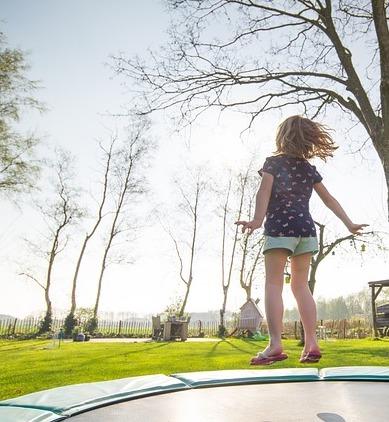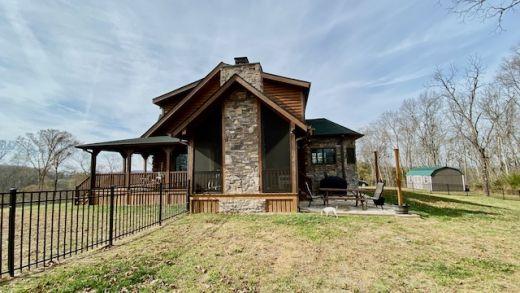They’re only kids once. That’s what we say to remind ourselves how fleeting childhood was for us and how quickly it will pass for our children and grandchildren. It’s also the reason that some homeowners opt to create a home play yard, fenced in for security.
The Honest Abe home shown above was custom designed and manufactured for a young couple with two small children. The couple fenced a large section of their backyard so the children could safely enjoy the outdoors.
Here is a basic plan for designing and building a safe and attractive fence for a residential children’s play yard:
- Determine the size and shape of the play yard: This will determine the amount of fencing material required and the overall layout of the fence.
- Choose a fencing material: There are many options to choose from, such as wood, vinyl, aluminum and steel. Consider the durability and maintenance requirements of each material, as well as the cost and aesthetic.
- Determine the height of the fence: The fence should be tall enough to prevent children from climbing over it, but not so tall that it blocks natural light or makes the play yard feel cramped. A height of 4-5 feet is typically sufficient for a play yard, but there may need to be a taller fence based on the particular circumstances and location.
- Design the fence: Plan out the layout of the fence, including any gates or access points. Make sure the fence is securely anchored in the ground, and that there are no sharp edges or protrusions that could be hazardous to children.
- Obtain necessary permits: check with local authorities to see if any permits are needed for building a fence in your area.
- Assemble and install the fence: This can be done by a professional fencing contractor, or as a DIY project with the help of a friend or family member.
- Finish the fence with appropriate paint or stain if using wood and maintain the fence as required.
- Add some attractive features around the play yard to make it inviting for children, such as a sandbox, swings or a small playhouse.
Finally, it’s important to test the fence to ensure it is completely safe for children, make sure the gate functions properly, check for any sharp edges, and fix them if they are found.
Note that this is a basic plan and depending on the specific location, codes and other factors, the plan may need to be adapted.
What kinds of surface materials are best for the home play yard?
The best surface materials for a home play yard depend on a variety of factors, including safety, cost and maintenance requirements. Here are a few options to consider:
Grass: Grass is a natural and attractive option that provides a soft surface for children to play on. However, it can be difficult to maintain and may become muddy in wet weather.
Mulch: Mulch is a cost-effective and low-maintenance option that provides a natural look and a soft surface for children to play on. It is also great for drainage.
Rubber mulch or Rubber tiles: Rubber mulch or tiles are made from recycled tires and are an ideal option for play yards because they are soft, durable, and slip-resistant. They also come in different colors and thickness.
Sand: Sand is another option that provides a soft surface for children to play on. It can be a good option for a sandbox, but it can be difficult to maintain and may get everywhere.
Concrete or asphalt: Concrete or asphalt can be a durable and low-maintenance option, but it can get hot in the sun and may not be as comfortable for children to play on. If you choose this type of material, it’s important to add some surface treatment such as paint or coatings to make it less slippery.
Artificial turf: Artificial turf can be a good option for a play yard because it is soft, slip-resistant, and requires little maintenance. However, It can be quite expensive.

Grass: Grass is a natural and attractive option that provides a soft surface for children to play on. However, it can be difficult to maintain and may become muddy in wet weather.
Mulch: Mulch is a cost-effective and low-maintenance option that provides a natural look and a soft surface for children to play on. It is also great for drainage.
Rubber mulch or Rubber tiles: Rubber mulch or tiles are made from recycled tires and are an ideal option for play yards because they are soft, durable, and slip-resistant. They also come in different colors and thickness.
Sand: Sand is another option that provides a soft surface for children to play on. It can be a good option for a sandbox, but it can be difficult to maintain and may get everywhere.
Concrete or asphalt: Concrete or asphalt can be a durable and low-maintenance option, but it can get hot in the sun and may not be as comfortable for children to play on. If you choose this type of material, it’s important to add some surface treatment such as paint or coatings to make it less slippery.
Artificial turf: Artificial turf can be a good option for a play yard because it is soft, slip-resistant, and requires little maintenance. However, It can be quite expensive.
Ultimately, the best surface material for a home play yard will depend on the specific needs of your family and the space you have available. It’s always a good idea to consult a professional landscaper or playground designer for advice and make sure the surface material is safe for children, since young children can ingest small pieces of many materials that are not safe for them.
What are the best gates for a residential outdoor children’s play yard?
When choosing gates for a residential outdoor children’s play yard, it’s important to consider safety, durability, and ease of use. Here are a few options to consider:
Wooden gates: Wooden gates are a popular option for residential play yards because they are sturdy and can be painted or stained to match the fence. They can also be customized to fit any size or shape of play yard. However, they require regular maintenance to keep them from rotting or warping.
Aluminum gates: Aluminum gates are another option that are lightweight, rust-resistant and require low maintenance. They are also less expensive than other options like wrought iron, but can be less durable over time.
Vinyl gates: Vinyl gates are similar to wooden gates in that they are easy to maintain and can be customized to fit any size or shape of play yard. They are also rot-proof and come in different colors, but they can be more expensive than wooden gates.
Steel gates: Steel gates are a strong and durable option that are resistant to wear and tear, but they are usually not as visually appealing as other options and can be quite heavy.
Wrought iron gates: Wrought iron gates are a durable and elegant option that can provide a high level of security, but they are usually more expensive than wooden or aluminum gates.
It’s also important to consider the locking mechanism of the gate. It’s best to choose a self-closing and self-latching gate with a locking mechanism that is out of the reach of children. It’s also a good idea to install an additional bolt or lock at the top of the gate to prevent children from opening it from the inside.
Finally, it’s important to ensure that the gate is installed properly and that there are no gaps or spaces where children could squeeze through. It’s always a good idea to consult with a professional to ensure the gate meets all safety standards and that it will be functional and safe for children.




